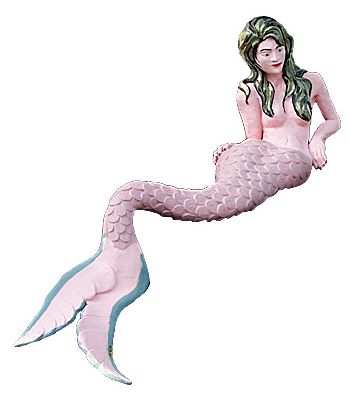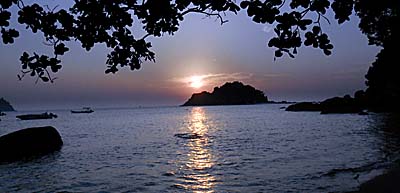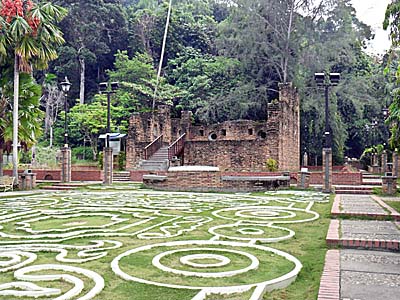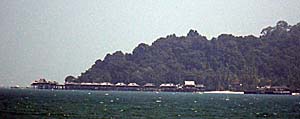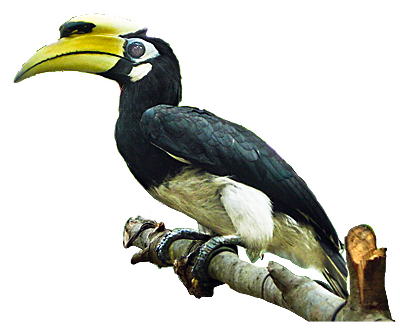
1.
A Tropical Island
Pangkor, a smaller island on the western shores of Malaysia, is mostly covered with tropical rainforest, of which a good part is still primary. That's why there are so many species living on Pangkor: eagles, monitor lizards, otters, two kinds of hornbills, wild pigs, macaques, seasonally big turtles who lay periodically eggs at Pangkor's cost after they swam thousands of kilometers through the Indian Ocean, a great deal of snakes, many cats, some dogs, and, of course, not few mosquitoes. If you are very lucky, you can see a sliding lizard 'flying' from one tree to another in the jungle.
Pulau Pangkor
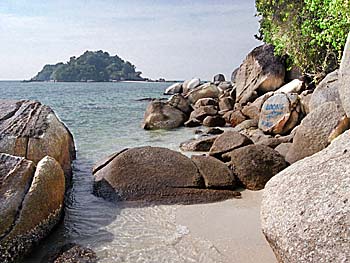
Pangkor Island's (Pulau Pangkor), west coast with view on Pulau Giam, one of many smaller islands shattered around here. Image by Asienreisender, 2005
On the western side of the island are, if the weather is fine, stunning sunsets to see.
Pangkor is clearly the only place in west Malaysia where it is worth to go when one wants to enjoy the nature and beaches. The most other parts of Malaysias west coast are industrialized and there is nothing interesting to do or to see. The east coast is very different from the west coast, but it's rather boring. It's dominated by Malayan villages without many Chinese or Indian inhabitants; the places are growing big and ugly, but they have nothing attractive. Although there are long sand beaches, the whole scenery is quite boring.
Pangkor's West Caost

Pangkors west coast. In the background lies Pangkor Laut. Image by Asienreisender, 2012
There is a ringroad surrounding the main piece of the island. Most of it's inner part is mountainous, partially very steep. Along the road, as always, urbanization is creeping cancerlike into the forest, but the steep slopes are impassable. If the forest will not be cut for the wood industries or burned, it might remain a tiny refuge for animals and plant species. On the Malaysian mainland urbanization grows in a rapid speed. Palmoil plantations, settlements and industries let the remaining forests disappear.
The best time to come here is around July, when the Muslims have ramadan and do not travel. Then it's rather quiet here, the beaches are mostly empty and there are no party activities around. Though, most of the restaurants are closed, but there are still some Chinese places to go for food. The most crowded time to come here is in December, when there are national holidays in Malaysia and half of the population is on the move. It's not easy then to get a room here, not to mention the room rates.
Hornbills

Hornbills at Pangkor's Teluk Nipah. There is clearly an overpopulation of them on the isle, because they are a popular tourist attraction and get fed by the locals. The big hornbills therefore are very seldom seen and never come close to people. They are also much fewer in number. Image by Asienreisender, 2012
Left of the main ferry pier (the 'jety') is Pangkor village situated, the island's urban center. Recently, shortly before 2012, the authorities built a roof above a part of the main road, which is 300 meters long. Quite bombastic for the small place. They also built a new, very big administration building, a bit outside of the village. A growing number of officials can now practice excessive idleness there. Partially there are sidewalks along the ringroad, but they are quite useless for pedestrians, because every 50 meters the planners put a big concrete flowerpot on them, which blockes the way. That's typical Southeast Asian - whatever they make, they have no concept and never get the point. Sidewalks are anyway in fact multi-purpose-stripes here. The authorities and city planners never care for pedestrians. They only care for cars, cars, cars and cars. Besides, I think, there is quite some money laundring going on here.
Malay Housing
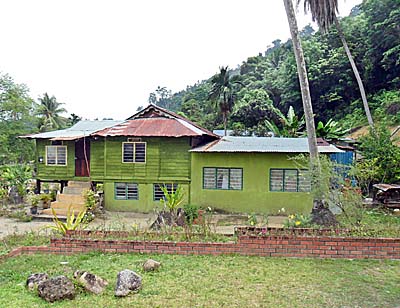
A Malayan house near the Dutch fort on Pangkor. On the road which leads to the fort is a hamlet (kampung) which looks very colourful, and the houses look quite cozy. It gives kind of a Caribbean impression. Image by Asienreisender, 2012
There are 20,000 to 25,000 people living on the small island. The population is quite mixed-up. There are many Chinese and Malays, and a smaller part of Indians living here. The Chinese, as always, are dominant in business. But there are many simple food stalls run by Malays. Generally I can say they all are not too friendly. They are spoiled by tourism and just mean business, including the notorious cheating. I have heard some complaints from western tourists about the unfriendlieness of the local restaurant owners. I could add a number by my own.
The Chinese restaurants in the main village are not often visited by foreigners. When going there, they are quite ignorant; they are used only to Chinese custumers. And they have quite a certain, remarkable style of communication. Short, choppy remarks, loudly uttered. They speak so in English as well as in Chinese. Their English is hard to understand; it's therefore also called 'Manglish'. If one inquires, they still don't make themselves clear.
I couldn't recommend a particular restaurant here. Years ago there was an Indonesian restaurant at Teluk Nipah, which served excellent food and was full with guests every evening. Not being early enough there in the evening meaned not to get a free table. The only really successfull restaurant here. But they closed. Locals told me they were mobbed out by their neighbours.
Photocompositions Pangkor Island
Impressions from Pangkor Island
Pangkor Island is one of these spoiled tourist destinations who could be great but aren't, because everything is commercialized and meanwhile crowded. The small island with it's various luxurious resorts has even an own airport. Smaller propellor machines (1) land and start here once a day. Some of the passengers go to the resort at Teluk Belanda with it's private beach (17), others continue straight to the neighbouring island of Pangkor Laut.
Traditionally most of the island's inhabitants were fishermen (3) and many still are. There are a lot of fisherboats at the piers of the easter side of Pangkor. That's probably the coast which is calmer and safer, for most of the winds and storms are approaching from the western side, the open sea. As everywhere, the coasts and fishing grounds are overfished and it's more and more difficult to make an income with fishing for the smaller fishers. The big trawlers therefore get the lion's share and do a lot of harm to the fisheries. The whole industries are not producing sustainable. The bigger fish get extinct first. Catches as to see on image 14 are past, and many species already died out.
The east coast is either steep mountain slopes, covered with tropical rainforest, or it's a rocky ground. There are certain species living here, some date back in evolutionary history over millions of years. Image 7 shows a sea cucumber. The western shores are those with several sand beaches. This environment invites other species to live here. The otters (8) were a great surprise. There is a beach called 'turtoise bay' where every year big turtles go to lay their eggs, after they crossed the ocean for thousands of kilometers.
There are a lot of restaurants and eateries on the island. Those at Teluk Nipah have been relocated in 2012. Before there were many beach restaurants, simple, rotten, wooden places who offered Malay food and seafood, mostly barbecue. Not seldom one smelled a penetrant ugly stench when passing by. Hygiene is a problem in whole Southeast Asia, and these places didn't have running water. Nevertheless, seeing the fish nicely displayed (9, 10, 11), they are an eye-catcher for a hungry man.

The coasts of a tropical island (12, 13). The huge rocks are typical for the west coast of the Malay Peninsula.
Pangkor is an island in the Strait of Malacca; that means that a great deal of the world's trade is passing by here (14).
The ringroad leads partially through the rainforest (15), as here in the easter, mountainous part of the island.
At Teluk Nipah, directly at the coast, is a small tao temple. Everywhere are funny statues placed, some are from Chinese legends or fairy tales, others are from Walt Disneys world of Mickey Mouse and Donald Duck. Meditative music is played there all the time and worshippers come to pray and donate for their gods and spirits.
Part of the island's ecology are many monitor lizards (18). They are sometimes a shocking experience for newcomers, often mixed-up with crocodiles or aligators. Well, there are no aligators in Southeast Asia, and crocodiles are extinct on the coasts of most of the Malay Peninsula, with the notable exception of the long coasts of Burma / Myanmar, north of Kawthaung and particularly in the Mergui Archipelago. Monitor lizards learned to live with humans, feeding from their garbage, taking shelter in sewer tunnels. And they are harmless to humans, except they are set under pressure.
The old Dutch fortress (20) is the only 'cultural' sight on the island. The Dutch East India Company (VOC) was keen in exploiting the country's riches, here particularly the tin production.
In the southeast of Pangor is a Malay village which looks pretty nice with it's colourful wooden houses and plenty of the beautiful flowers around them (21, 22). It has a Carribean touch and one morning I accompanied a professional photographer to the place making some shots there.
Pangkor's sunsets are spectacular, and every evening it looks still different with a great variety of colours.
The Tropical Rainforest of Pangkor Island
Bukit Pangkor, the peak of the biggest hill or mountain of the island, is in the background left (1), here seen from the small tao temple at the northern edge of Teluk Nipah.
Most of the island is still covered with tropical rainforest. That's more and more exceptional - most of the lowland rainforests on the Malay Peninsula fell already victim to the ever hungry and growing oil palm and rubber plantations. The steep slopes of Pangkor's mountains are not good for plantation economy, and the logging industries haven't butchered the nature here yet, for it's probably easier to butcher first elsewhere. Logging in the mountains is more expensive and less profitable than logging in the plains, so they go into the mountains when the plains are all done. But also without the grand logging companies the rainforest is cut more and more, and urbanization is eating it's way into the green (27, 28). The village on image 28 has occupied a valley which lies at the foot of Fu Ling Kung Temple, who is built already into the slope of a mountain.
Leeches
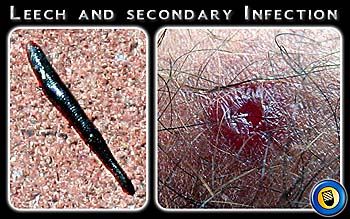
When entering the tropical rainforest with it's humidity one encounters another tease, who attacks in great number: leeches. Although it's always said they were completely harmless, I was so lucky to catch a secondary infection, probably directly transferred by the insect. It got worse every day and I had to treat it (with hydrogen peroxide).
A method to protect oneself from them is to pour salt into the socks. It's just that salt goes with the water, where they live in. Wearing long pants in the forest is anyway recommendable; to pack the trouser legs into the socks works well. However, in rainy days they crouch quickly over the whole body and find their way under the clothes... To get rid of them is possible with burning them with a lighter (they let go then) or scratch them away with a straw directly after they bit and are not firm yet.
Image and photocomposition by Asienreisender, 2009, 2015
From Teluk Nipah are two paths leading into the jungle. At the edge of the jungle the peak is still to see (2). Once being inside the green, orientation is a problem and a compass can help a lot.
Huge trees indicate the age of the forest. These are older trees, while further south there is a part of the forest where only thin, young trees are growing. That's clearly secondary forest. The tall trees have a huge crown but no branches below. They are specialized to absorb the sunlight and form the top layer of the tropical rainforest (4,5,7,9). Lianas appear very often in the jungle; they are parasitic plants who use the jungle giants as an access to reach the sunlight high above. In some cases the parasites strangulate the old trees and eventually kill them.
Big spiders appeare here and there, more often at the edge of the forest than inside. They prefer glades for their nets, because there is the chance higher to catch prey.
The yellow sign inmiddle of the forest tells that the forest is under protection and asks hikers to take care for the nature.
When hiking in the jungle, one starts sweating pretty much. The heat, the humidity, the strain of walking on a ground where one has permanently to watch out... Plenty of water is required for any even very short walk into the forest. Mosquitoes are attracted by the smell of sweat. Sometimes whole swarms approach the hiker, and one can't get rid of them anymore. They fly around the whole body and check where they can bite. Some are permanently buzzing around the head. The mosquitoes around image 8 are aedes albopictus, the notorious 'asian tiger mosquito', which is the vector for dengue fever. Plenty of them live at the long west coasts of the Malay Peninsula. Aedes albopictus is day-active.
The mosquitoes around image 18 are of the kind anopheles. Anopheles mosquitoes can transfer malaria, a classic tropical disease.
As well as mosquitoes there are also masses of ants in the forest. Many of the fallen trunks (12) in the jungle fall victim then to termits (11).

Jungle tracks (13 - 18) - very seldom someone comes along here. They are from time to time cleared by officials who observe the nature; maybe there are also sometimes locals hunting in the forest - hunting means meat for free. The tracks are narrow and at many spots overgrown, so then one has to crawl for a few meters or to use a machete (19) to clear the path. The machete probably saved my life when I used it to lift a few twists under where was a pretty viper hidden (20). The picture is (not only) so shaky for I was trembling but because it's pretty dark on the ground of the tropical rainforest. For the plants it's a permanent struggle for light. Image 21 shows a part of a track which is overgrown with fern. Because of some more poisonous animals like cobras, centipedes, scorpions it's recommendable not to pass through here. One has to clear the path first.
Suddenly, in the mud, the footprints of boars (22). Continuing slowly and silently, the group of wild pigs didn't notice me before I saw them (23). Wild boars are certainly a reason for hunters to poach. One would think that's an activity for the Chinese then, because the muslim majority doesn't eat pork. But, hunting and eating are two different things, and a poached boar can be sold for 'good money'.
Orchids grow on branches, they are parasites as well (24). Hiking in the jungle requires a good sense for orientation, and an orchid like this is like a sign one should keep in mind for the way back. Fallen trees serve for the same purpose (25). And, after walking, walking, walking, eventually a stone indicates that the peak of the mountain is very close (26).
Pangkor Island was for years a very fine destination. It's a tropical island in a half-way developed country in which I felt safe in recent years. It was also so that the people here were mostly friendly and I remember a number of good experiences I made here. Hiking into the jungle was always a great experience. I never ever met anybody else in Pangkor's jungle, and also never ever met a local who had an idea how it looks in the island's forests. The locals are very estranged and don't spent a thought for the nature. They mean business, and only business.
However, in the last years the situation changed considerably. Social change and development are progressing rapidly in Southeast Asia, and many things are getting worse. It is absolutely clear that all the Southeast Asian societies have a huge problem with drugs, namely metamphetamines. And the state institutions who deal with that, so far they can't ignore it anymore, respond in the usual styereotype and authoritarian manner. And fail. They fail, because stricter laws, beatings, imprisonment and death penalty don't grasp the problem at the roots. The idiotic state buerocracies act when it's far too late.
So, while Pangkor was a great place to go and to enjoy the nature and to meet interesting fellow travellers, it's getting more and more busy these days. The rising middle classes produce an often neglected offspring who come here for drug parties and action. Traffic is rising, and it's a major mistake to allow private vehicles on the island, particularly cars. Nevertheless, it seems that at least the forest remains still mostly untouched by the ongoing urbanization, thanks to the mountainous surroundings.
Click the chapters to access the photocompositions of Pangkor Island.
All images and photocompositions by Asienreisender, 2005, 2007, 2009, 2010, 2012, 2015
Health Concerns
There are serious concerns about visiting Pangkor Island. It's not only that the place is not really safe (see below: 'A Raid on Pangkor'); it's also that I got several reports about tropical diseases transferred by mosquitoes, particularly dengue fever and chikungunya fever, also malaria. These health threats do not only concern Pangkor, but the whole coast including Penang and also further up Thailand's Andaman coasts. The consequences are not seldom really serious. Patients suffer a deep, long-term health impact, sometimes lasting a life long. Particularly in monsoon season mosquitoes appear in great amounts and are very aggressive. I personally didn't see so many mosquitoes like this time on Pangkor since long. They were a plague. In 2011 there were 19.900 registered cases of dengue fever in west Malaysia; 36 were fatal. 2010 there were 44,600 cases of dengue registered. I don't trust the statistics. I suppose, the real number is much higher. It's therefore highly crucial to take care by using mosquito repellents and other means of protection.
When coming from Thailand bring much of the stuff with you: repellents in Malaysia cost almost three times the price as the same products cost in Thailand.
Map of Pangkor Island
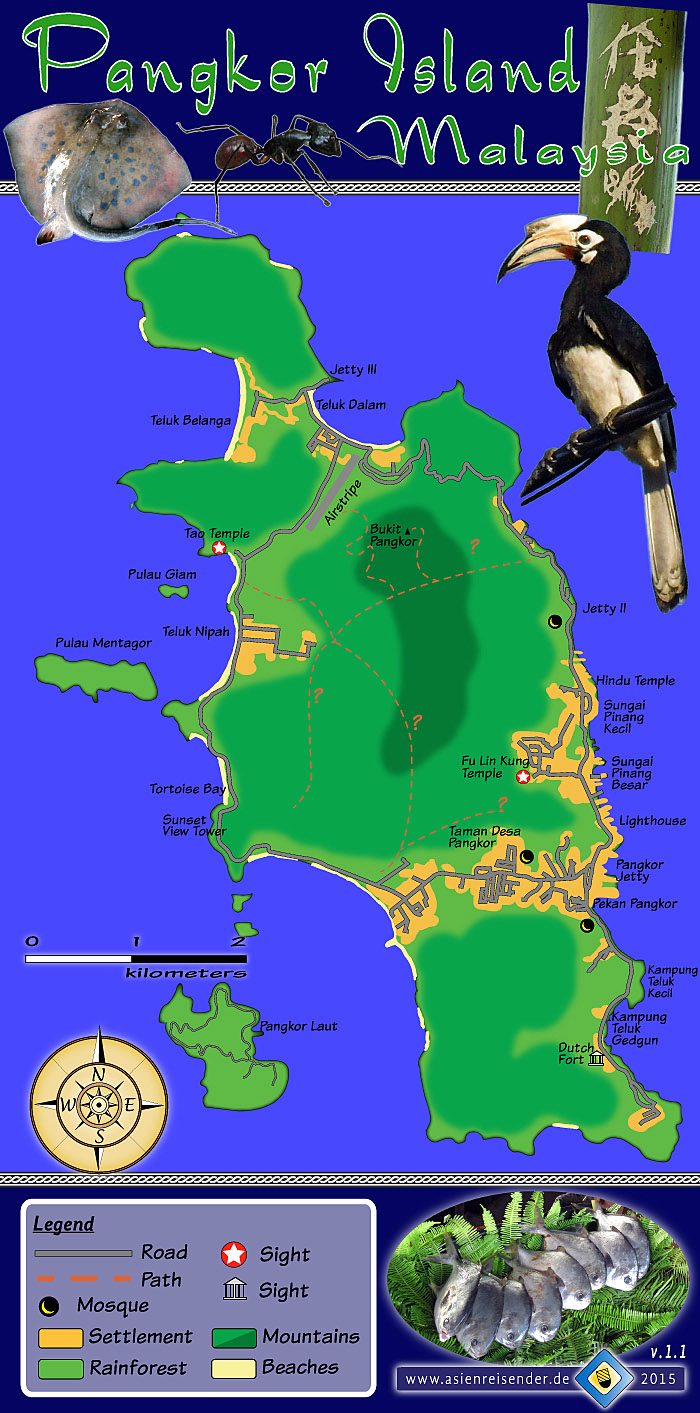
The tracks into the island's mountains are in a bad and ever changing state. Sometimes there is an expedition following them and chopping the paths free, but at last in the next rainy season the vegetation will overgrow them again. A machete is therefore a basic tool. Not having one means to be stopped by dense bushes or green of different kind. The question marks show parts of the tracks who were so overgrown and blocked repeatedly by fallen jungle trees, that I rather decided to go back.
There is also a path leading into the southern part of the island, but honestly, I didn't find it. Probably even more seldom people go here.
The locals anyway have no idea about the island's nature, since they are exclusively fixed on their businesses.
